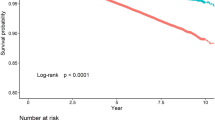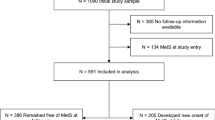Abstract
Objective:
To test the hypothesis that for any given body mass index (BMI) category, active individuals would have a smaller waist circumference than inactive individuals. Our second objective was to examine the respective contribution of waist circumference and physical inactivity on coronary heart disease (CHD) risk.
Design:
Prospective, population-based study with an 11.4-year follow-up.
Subjects:
A total of 21 729 men and women aged 45–79 years, residing in Norfolk, UK.
Methods:
During follow-up, 2191 CHD events were recorded. Physical activity was evaluated using a validated lifestyle questionnaire that takes into account both leisure-time and work-related physical activity. Waist circumference was measured and BMI was calculated for each participant.
Results:
For both men and women, we observed that within each BMI category (<25.0, 25–30 and ⩾30.0 kg m−2), active participants had a lower waist circumference than inactive participants (P<0.001). In contrast, within each waist circumference tertile, BMI did not change across physical activity categories (except for women with an elevated waist circumference). Compared with active men with a low waist circumference, inactive men with an elevated waist circumference had a hazard ratio (HR) for future CHD of 1.74 (95% confidence interval (CI), 1.34–2.27) after adjusting for age, smoking, alcohol intake and parental history of CHD. In the same model and after further adjusting for hormone replacement therapy use, compared with active women with a low waist circumference, inactive women with an elevated waist circumference had an HR for future CHD of 4.00 (95% CI, 2.04–7.86).
Conclusion:
In any BMI category, inactive participants were characterized by an increased waist circumference, a marker of abdominal adiposity, compared with active individuals. Physical inactivity and abdominal obesity were both independently associated with an increased risk of future CHD.
This is a preview of subscription content, access via your institution
Access options
Subscribe to this journal
Receive 12 print issues and online access
$259.00 per year
only $21.58 per issue
Buy this article
- Purchase on Springer Link
- Instant access to full article PDF
Prices may be subject to local taxes which are calculated during checkout
Similar content being viewed by others
References
Després JP, Lemieux I . Abdominal obesity and metabolic syndrome. Nature 2006; 444: 881–887.
Grundy SM . Obesity, metabolic syndrome, and cardiovascular disease. J Clin Endocrinol Metab 2004; 89: 2595–2600.
Yusuf S, Hawken S, Ounpuu S, Bautista L, Franzosi MG, Commerford P et al. Obesity and the risk of myocardial infarction in 27 000 participants from 52 countries: a case-control study. Lancet 2005; 366: 1640–1649.
Pischon T, Boeing H, Hoffmann K, Bergmann M, Schulze MB, Overvad K et al. General and abdominal adiposity and risk of death in Europe. N Engl J Med 2008; 359: 2105–2120.
Balkau B, Deanfield JE, Després JP, Bassand JP, Fox KA, Smith Jr SC et al. International Day for the Evaluation of Abdominal Obesity (IDEA): a study of waist circumference, cardiovascular disease, and diabetes mellitus in 168 000 primary care patients in 63 countries. Circulation 2007; 116: 1942–1951.
Canoy D, Boekholdt SM, Wareham N, Luben R, Welch A, Bingham S et al. Body fat distribution and risk of coronary heart disease in men and women in the European Prospective Investigation Into Cancer and Nutrition in Norfolk cohort: a population-based prospective study. Circulation 2007; 116: 2933–2943.
Ford ES, Capewell S . Coronary heart disease mortality among young adults in the US From 1980 through 2002: concealed leveling of mortality rates. J Am Coll Cardiol 2007; 50: 2128–2132.
Ford ES, Mokdad AH, Giles WH . Trends in waist circumference among US adults. Obes Res 2003; 11: 1223–1231.
Rodriguez BL, Curb JD, Burchfiel CM, Abbott RD, Petrovitch H, Masaki K et al. Physical activity and 23-year incidence of coronary heart disease morbidity and mortality among middle-aged men. The Honolulu Heart Program. Circulation 1994; 89: 2540–2544.
Hu G, Jousilahti P, Borodulin K, Barengo NC, Lakka TA, Nissinen A et al. Occupational, commuting and leisure-time physical activity in relation to coronary heart disease among middle-aged Finnish men and women. Atherosclerosis 2007; 194: 490–497.
Hu FB, Willett WC, Li T, Stampfer MJ, Colditz GA, Manson JE . Adiposity as compared with physical activity in predicting mortality among women. N Engl J Med 2004; 351: 2694–2703.
Kannel WB . Habitual level of physical activity and risk of coronary heart disease: the Framingham study. Can Med Assoc J 1967; 96: 811–812.
Li TY, Rana JS, Manson JE, Willett WC, Stampfer MJ, Colditz GA et al. Obesity as compared with physical activity in predicting risk of coronary heart disease in women. Circulation 2006; 113: 499–506.
Day N, Oakes S, Luben R, Khaw KT, Bingham S, Welch A et al. EPIC-Norfolk: study design and characteristics of the cohort. European Prospective Investigation of Cancer. Br J Cancer 1999; 80 (Suppl 1): 95–103.
Boekholdt SM, Peters RJ, Day NE, Luben R, Bingham SA, Wareham NJ et al. Macrophage migration inhibitory factor and the risk of myocardial infarction or death due to coronary artery disease in adults without prior myocardial infarction or stroke: the EPIC-Norfolk Prospective Population study. Am J Med 2004; 117: 390–397.
Wareham NJ, Jakes RW, Rennie KL, Schuit J, Mitchell J, Hennings S et al. Validity and repeatability of a simple index derived from the short physical activity questionnaire used in the European Prospective Investigation into Cancer and Nutrition (EPIC) study. Public Health Nutr 2003; 6: 407–413.
Friedewald WT, Levy RI, Fredrickson DS . Estimation of the concentration of low-density lipoprotein cholesterol in plasma, without use of the preparative ultracentrifuge. Clin Chem 1972; 18: 499–502.
Simmons RK, Sharp S, Boekholdt SM, Sargeant LA, Khaw KT, Wareham NJ et al. Evaluation of the Framingham risk score in the European Prospective Investigation of Cancer-Norfolk cohort: does adding glycated hemoglobin improve the prediction of coronary heart disease events? Arch Intern Med 2008; 168: 1209–1216.
Rana JS, Li TY, Manson JE, Hu FB . Adiposity compared with physical inactivity and risk of type 2 diabetes in women. Diabetes Care 2007; 30: 53–58.
Hu G, Tuomilehto J, Silventoinen K, Barengo N, Jousilahti P . Joint effects of physical activity, body mass index, waist circumference and waist-to-hip ratio with the risk of cardiovascular disease among middle-aged Finnish men and women. Eur Heart J 2004; 25: 2212–2219.
Lee CD, Blair SN, Jackson AS . Cardiorespiratory fitness, body composition, and all-cause and cardiovascular disease mortality in men. Am J Clin Nutr 1999; 69: 373–380.
Rana JS, Arsenault BJ, Després JP, Côté M, Talmud PJ, Ninio E et al. Inflammatory biomarkers, physical activity, waist circumference, and risk of future coronary heart disease in healthy men and women. Eur Heart J 2009 [e-pub ahead of print 18 February 2009].
Wong SL, Katzmarzyk P, Nichaman MZ, Church TS, Blair SN, Ross R . Cardiorespiratory fitness is associated with lower abdominal fat independent of body mass index. Med Sci Sports Exerc 2004; 36: 286–291.
Arsenault BJ, Lachance D, Lemieux I, Alméras N, Tremblay A, Bouchard C et al. Visceral adipose tissue accumulation, cardiorespiratory fitness, and features of the metabolic syndrome. Arch Intern Med 2007; 167: 1518–1525.
Janssen I, Katzmarzyk PT, Ross R . Waist circumference and not body mass index explains obesity-related health risk. Am J Clin Nutr 2004; 79: 379–384.
Seidell JC, Visscher TL . Body weight and weight change and their health implications for the elderly. Eur J Clin Nutr 2000; 54 (Suppl 3): S33–S39.
Sniderman AD, Bhopal R, Prabhakaran D, Sarrafzadegan N, Tchernof A . Why might South Asians be so susceptible to central obesity and its atherogenic consequences? The adipose tissue overflow hypothesis. Int J Epidemiol 2007; 36: 220–225.
Acknowledgements
We thank the participants, general practitioners and staff in EPIC-Norfolk. EPIC-Norfolk was supported by program grants from the Medical Research Council UK and Cancer Research UK and with additional support from the European Union, Stroke Association, British Heart Foundation, and Research into Ageing. None of the study sponsors have had any role in study design, collection analysis and interpretation of data, writing of the report or decision to submit the paper for publication. Jean-Pierre Després is Scientific Director of the International Chair on Cardiometabolic Risk, which is supported by an unrestricted grant awarded to Université Laval by Sanofi Aventis.
Author information
Authors and Affiliations
Corresponding author
Rights and permissions
About this article
Cite this article
Arsenault, B., Rana, J., Lemieux, I. et al. Physical inactivity, abdominal obesity and risk of coronary heart disease in apparently healthy men and women. Int J Obes 34, 340–347 (2010). https://doi.org/10.1038/ijo.2009.229
Received:
Revised:
Accepted:
Published:
Issue Date:
DOI: https://doi.org/10.1038/ijo.2009.229
Keywords
This article is cited by
-
Level of cardiovascular disease knowledge, risk perception and intention towards healthy lifestyle and socioeconomic disparities among adults in vulnerable communities of Belgium and England
BMC Public Health (2022)
-
Analyzing spatial variations of heart disease and type-2 diabetes: A multi-scale geographically weighted regression approach
Computational Urban Science (2022)
-
Validation of the Dutch-Flemish translated ABCD questionnaire to measure cardiovascular diseases knowledge and risk perception among adults
Scientific Reports (2021)
-
Risk factors associated with coronary heart disease in women: a systematic review
Herz (2020)
-
Promoting workplace stair climbing: sometimes, not interfering is the best
Archives of Public Health (2017)



